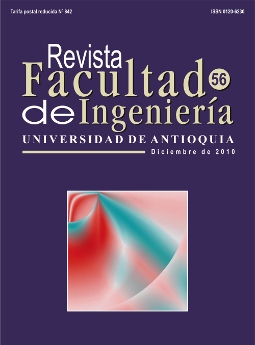Semi-fragile watermarking based content image authentication scheme
DOI:
https://doi.org/10.17533/udea.redin.14664Keywords:
semi-fragile watermarking, self-correcting, recovery, image authentication, securityAbstract
This paper presents a block-wise semi-fragile watermarking scheme for image content authentication, with tamper area localization and recovery capability. Before the watermark sequence is generated, the original image is divided into two regions: The Region of Interest (ROI) and the Region of Embedding (ROE), where the ROI is selected manually by the owner of the image and the ROE is rest of the whole image after subtracting region belonging to the ROI. The binary watermark of each ROI block is generated by the DC and the 6 lowest AC components in the zig-zag order of the DCT coefficients of these blocks. These extracted bit sequence are embedded into the LSB of the DCT coefficients of the corresponding ROE blocks which are indicated by a mapping list previously generated using a secret key. In the authentication process, the watermark sequence is extracted from the ROI blocks. Then it is compared with the sequence extracted from the corresponding ROE blocksto determine if the ROI block has been altered; in this case the tampered ROI blocks are recovered replacing them by the extracted watermark sequence from ROE. Simulation results show that the reconstructed image quality and the watermark robustness to JPEG compression are better than the previously reported methods by other authors under the same conditions.
Downloads
References
C. S. Lu, H. Y. Liao. “Structural Digital Signature for Image Authentication: An Incidental Distortion Resistant Scheme”. IEEE Trans. Multimedia. Vol. 5. 2003. pp.161-173. DOI: https://doi.org/10.1109/TMM.2003.811621
D. C. Lou, J. L. Ju, “Fault Resilient and Compression Tolerant Digital Signature for Image authentication”. IEEE Trans. Consumer Electron. Vol. 46. 2000. pp. 31-39. DOI: https://doi.org/10.1109/30.826378
P. W. Wong, N. Memon. “Secret and Public Key Image Watermarking Schemes for Image Authentication and Ownership Verification”. IEEE Trans. Image processing. Vol. 10. 2001. pp. 1593-1601. DOI: https://doi.org/10.1109/83.951543
K. Maeno, Q. Sun, S. F. Chang, M. Suto. “New Semi-Fragile Image Authentication Watermarking Techniques Using Random Bias and Nonuniform Quantization”. IEEE Trans. Multimedia. Vol. 8. 2006. pp. 32-45. DOI: https://doi.org/10.1109/TMM.2005.861293
P. L. Lin, C. K. Hsieh, P. W. Huang. “Hierarchical Watermarking Scheme for Image Authentication and Recovery”. IEEE Int. Conf. on Multimedia and Expo. Taipei. Taiwan.Vol. 2. 2004. pp. 963-966.
J. Fridrich, M. Goljan. “Image with Self-Correcting Capabilities”. Int. Conf. on Image Processing. Kobe. Japan. Vol. 3. 1999. pp. 792-796.
P. Tsai, Y. C. Hu. “A Watermarking-Based Authentication with Malicious Detection and Recovery”. Int. Conf. of Information, Communication and Signal Processing. Bankok. Thailand. Vol. 1. 2005. pp. 865-869.
X. Zhao, A. Ho, H. Trehame, V. Pankajakshan, C. Culnane, W. Jiang. “A Novel Semi-Fragile Image Watermarking Authentication and Self-Restauration Technique Using Slant Transform”. 3rd Int. Conf. on Intelligent Information Hiding and Multimedia Signal Processing. Vol. 1. 2007. pp. 283-286. DOI: https://doi.org/10.1109/IIH-MSP.2007.50
Y. Hasan, A. Hassan. “Tamper Detection with Self Correction on Hybrid Spatial-DCT Domains Image Authentication Technique”. IEEE Int. Symp. on Signal Processing and Information Technology. Cairo. Egypt. 2007. pp. 608-613. DOI: https://doi.org/10.1109/ISSPIT.2007.4458195
Downloads
Published
How to Cite
Issue
Section
License
Copyright (c) 2018 Revista Facultad de Ingeniería

This work is licensed under a Creative Commons Attribution-NonCommercial-ShareAlike 4.0 International License.
Revista Facultad de Ingeniería, Universidad de Antioquia is licensed under the Creative Commons Attribution BY-NC-SA 4.0 license. https://creativecommons.org/licenses/by-nc-sa/4.0/deed.en
You are free to:
Share — copy and redistribute the material in any medium or format
Adapt — remix, transform, and build upon the material
Under the following terms:
Attribution — You must give appropriate credit, provide a link to the license, and indicate if changes were made. You may do so in any reasonable manner, but not in any way that suggests the licensor endorses you or your use.
NonCommercial — You may not use the material for commercial purposes.
ShareAlike — If you remix, transform, or build upon the material, you must distribute your contributions under the same license as the original.
The material published in the journal can be distributed, copied and exhibited by third parties if the respective credits are given to the journal. No commercial benefit can be obtained and derivative works must be under the same license terms as the original work.










 Twitter
Twitter